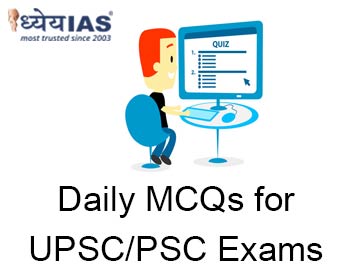Home > Daily-mcqs
Daily-mcqs 15 May 2025

Q1:
With reference to the Bhakra-Nangal Water Dispute, consider the following statements: How many of the above statements are correct?
A: Only one
B: Only two
C: Only three
D: All four
Answer: B
Explanation:
Q2:
Which of the following statements best describes the concept of intermediary liability?
A: Intermediary liability holds online platforms responsible only for their own content.
B: Intermediary liability holds companies accountable for environmental damage caused by their operations, even if not directly involved in the harm.
C: Intermediary liability holds platforms responsible for content they facilitate or distribute, especially when notified of unlawful content.
D: Intermediary liability ensures that intermediaries, such as shipping companies, are not responsible for the goods they transport, as long as the goods are not damaged during transit.
Answer: C
Explanation:
Statement (c) correctly defines intermediary liability as holding platforms responsible for content when they are notified of unlawful content. If platforms fail to act, they lose safe harbour protection.
Q3:
Which of the following is a key objective of the Digital Lending Directions, 2025 issued by the Reserve Bank of India (RBI)?
A: To promote unrestricted access to digital lending for all citizens
B: To enhance borrower protection and ensure data transparency in digital lending
C: To regulate only the interest rates charged by digital lenders
D: To allow automatic credit limit increases without borrower consent
Answer: B
Explanation:
The correct answer is (b). The Digital Lending Directions, 2025, primarily aim to promote responsible lending practices, enhance borrower protection, ensure data transparency, and regulate the roles of Regulated Entities (REs) and Lending Service Providers (LSPs).
Q4:
Consider the following statements: Statement 1: The Extended Fund Facility (EFF) provides grants to low-income countries for immediate relief.
Statement 2: The EFF is used by the IMF to support medium-term structural reforms in countries facing chronic balance of payments issues.
A: Both statements are correct, and Statement 2 explains Statement 1
B: Both statements are correct, but Statement 2 does not explain Statement 1
C: Statement 1 is incorrect, but Statement 2 is correct
D: Both statements are incorrect
Answer: C
Explanation:
EFFs are not grants; they are loans that must be repaid. Statement 1 is thus incorrect. Statement 2 correctly describes the purpose of EFFs—to address medium-term structural problems like fiscal mismanagement, weak banking systems, etc. These loans come with conditions for long-term economic reform.
Q5:
Identify the incorrect statement about the legal and ecological status of the Delhi Ridge:
A: The Ridge is divided into Southern, Central, Northern, and Northwestern zones.
B: The Ridge Management Board has no legal authority to review land use changes.
C: The Ridge supports dry thorn forests and native drought-resistant species.
D: The Supreme Court’s directives provide protection even to non-notified Ridge areas.
Answer: B
Explanation:
Statement B is incorrect. The Ridge Management Board (RMB) was specifically created to review and approve any proposed land use changes within the Ridge and Morphological Ridge areas, alongside the Central Empowered Committee. Statements A, C, and D are all accurate. The Ridge is ecologically rich and zonally divided; it supports native biodiversity and has de facto protection through Supreme Court judgments. This question evaluates legal interpretation and tests whether students can distinguish between statutory gaps and judicial mandates.
Q6:
What is the primary function of geotubing technology in coastal areas?
A: To generate tidal energy by trapping wave currents
B: To promote marine biodiversity through artificial reefs
C: To absorb and dissipate wave energy, reducing shoreline erosion
D: To reclaim land for infrastructure development
Answer: C
Explanation:
Geotubes are fabric containers filled with sand or slurry placed along coastlines. Their primary purpose is to mitigate coastal erosion by reducing wave energy before it hits the shore, allowing for sand deposition and beach formation. They are not energy-generating structures nor primarily for biodiversity or land reclamation.
Q7:
Which of the statements given above is/are correct?Consider the following statements regarding the PM SHRI Scheme:
A: 1 and 2 only
B: 2 only
C: 2 and 3 only
D: 1, 2 and 3
Answer: B
Explanation:
Q8:
Which of the following statements best describes the difference between a geomagnetic reversal and an excursion?
A: A reversal involves the magnetic poles flipping temporarily, while an excursion is a permanent change.
B: A reversal leads to a complete and long-lasting polarity switch, while an excursion is a brief and partial deviation.
C: Reversals are caused by solar storms; excursions are due to asteroid impacts.
D: Excursions occur only in polar regions; reversals affect the entire Earth.
Answer: B
Explanation:
Reversals last over 100,000 years, involving a full magnetic polarity switch.
Excursions are short-lived, often returning to the original polarity, and don’t last long enough to be considered true reversals.